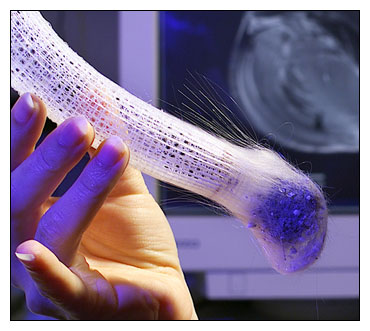MURRAY HILL, N.J., August 22 -- Scientists from Lucent Technologies' Bell Labs have found that a deep-sea sponge contains optical fiber that is remarkably similar to the optical fiber found in today's state-of-the-art telecommunications networks.
The deep-sea sponge's glass fiber, designed through the course of evolution, may possess certain technological advantages over industrial optical fiber, the scientists report in today's issue of the journal Nature.
"We believe this novel biological optical fiber may shed light on new bio-inspired processes that may lead to better fiber optic materials and networks," said Joanna Aizenberg, the Bell Labs materials scientist who led the research team. "Mother Nature's ability to perfect materials is amazing, and the more we study biological organisms, the more we realize how much we can learn from them."
The discovery of marine optical fiber is the latest Bell Labs contribution in the emerging field of science known as biomimetics, which takes engineering principles from the natural world and applies them to manmade materials and technologies.

FIBER, HOLD THE SHRIMP: Euplectella, commonly known as the Venus Flower Basket, the deep sea sponge that grows its own highly-advanced optical fibers. It has an intricate cylindrical mesh-like skeleton of glassy silica, and -- unlike manmade fibers -- a pair of mating shrimp often lives inside it.
The sponge in the study, Euplectella, lives in the depths of the ocean in the tropics and grows to about half a foot long. Commonly known as the Venus Flower Basket, it has an intricate cylindrical mesh-like skeleton of glassy silica, and a pair of mating shrimp often lives inside it. At the base of the sponge's skeleton is a tuft of fibers that extends outward like an inverted crown. Typically, these fibers are between two and seven inches long and about the thickness of a human hair.
The research team found that each of the sponge's fibers comprises distinct layers with different optical properties. Concentric silica cylinders with high organic content surround an inner core of high-purity silica glass, a structure similar to industrial optical fiber, in which layers of glass cladding surround a glass core of slightly different composition. The researchers found during experiments that the biological fibers of the sponge conducted light beautifully when illuminated and used the same optical principles that modern engineers have used to design industrial optical fiber. "These biological fibers bear a striking resemblance to commercial telecommunications fibers, as they use the same material and have similar dimensions," said Aizenberg.
Though these natural bio-optical fibers do not have the superbly high transparency needed for modern telecommunication networks, the Bell Labs researchers found that these fibers do have a big advantage in that they are extremely resilient to cracks and breakage. Although extremely reliable, one of the main causes for outages in commercial optical fiber is fracture resulting from crack growth within the fiber. Infrequent as an outage is, when it occurs, replacing the fiber is often a costly, labor-intensive proposition, and scientists have sought to make fiber that is less susceptible to this problem.
The sponge's solution is to use an organic sheath to cover the biological fiber, Aizenberg and her colleagues discovered. "These bio-optical fibers are extremely tough," she said. "You could tie them in tight knots and, unlike commercial fiber, they would still not crack. Maybe we can learn how to improve on existing commercial fiber from studying these fibers of the Venus Flower Basket," she said.
Another advantage of these biological fibers is that they are formed by chemical deposition at the temperature of seawater. Commercial optical fiber is produced with the help of a high-temperature furnace and expensive equipment. Aizenberg said, "If we can learn from nature, there may be an alternative way to manufacture fiber in the future."
Should scientists succeed in emulating these natural processes, they may also help reduce the cost of producing optical fiber. "This is a good example where Mother Nature can help teach us about engineering materials," said Cherry Murray, senior vice president of physical sciences research at Bell Labs. "In this case, a relatively simple organism has a solution to a very complex problem in integrated optics and materials design. By studying the Venus Flower Basket, we are learning about low-cost ways of forming complex optical materials at low temperatures. While many years away from being applied to commercial use, this understanding could be very important in reducing the cost and improving the reliability of future optical and telecommunications equipment."
Other members of the research team were Bell Labs materials scientists Vikram Sundar and John Grazul, as well as zoologist Micha Ilan of Tel Aviv University and optics researcher Andrew Yablon of OFS Laboratories.
The study of biomimetics at Bell Labs is part of the quest to find better materials for technology and industry, and has proved remarkably fruitful. Two years ago, Aizenberg and her collaborators made the surprising discovery that thousands of chalk-like calcite crystals spread throughout the exoskeletons of brittlestars, starfish-like marine invertebrates, collectively form an unusual kind of compound eye for the animals. The brittlestar's calcite microlenses expertly compensate for birefringence and spherical aberration, two common types of distortions in lenses. This led the Bell Labs scientists to attempt to mimic nature's success and design crystals based on the brittlestar model, with the ultimate goal of building complex arrays of microlenses similar to the brittlestar's own lenses.
Earlier this year, Aizenberg and her colleagues developed a new crystallization approach that allowed them to directly fabricate single crystals of calcite that were about one-tenth of a centimeter across. These had patterns less than ten micrometers across, which is approximately one-tenth the diameter of a human hair -- an approach that may revolutionize how crystals are made in the future for a wide variety of applications. Single crystals patterned at the micron scale or smaller and integrated into opto-electronic circuits are important components needed to engineer highly advanced electronic, sensory and optical devices.
For more information, visit: www.bell-labs.com